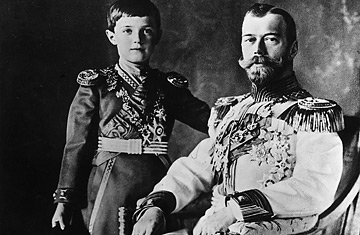
Nicholas II, Emperor of Russia with his son Alexei.
One of Russia's most intriguing mysteries has added yet another chapter. On July 29 archaeologists announced that they had discovered near Yekaterinburg in the Urals the remains of a young boy and adolescent woman thought to be the 13-year-old Crown Prince Alexei, son of the last Russian Emperor Nicholas Romanov, and Alexei's sister, believed to be 19-year-old Maria. The remains —bone fragments, teeth, bullets and fragments of ceramic bottles supposedly used by the executioners to carry sulfuric acid to mutilate the bodies beyond recognition — have pushed Russian state prosecutors to re-launch a probe to investigate the Imperial family's murder.
Back in July 1918, Lenin feared that the deposed Emperor Nicholas would re-emerge as a rallying symbol for anti-Bolshevik forces and secretly ordered the entire family executed. The Emperor, the Empresses Alexandra, Alexei and his four sisters, lovingly called "OTMA" by the family — Olga, Tatyana, Maria, Anastasia — all were brutally shot in the basement of the Ipatyev House in Yekaterinburg, where they were kept in exile. The bodies were thought to be covered in sulphuric acid and buried in secret graves nearby. They were exhumed in 1991, but two were missing — the boy and one of the girls.
A probe into the Romanov family murders was opened in 1993 at the climax of the democratization wave, with the goal of exposing the Bolshevik regime's brutality. Ironically, the Romanov family, justly seen as victims of Bolsheviks' bloody terror, were an emblem for the growing anti-Yeltsin Nationalist forces, a real menace to the then embattled President who toppled the regime that had the Romanovs murdered. The probe was quietly suspended in 1997. Yeltsin accepted his advisers' suggestions, and in July 1998, on the 80th anniversary of the Imperial family's execution, the remains were laid in state in the Romanov Dynasty burial place in the Petropavlovsky Cathedral in St. Petersburg. Yeltsin saw this as a humane act of repentance — and a smart step to defuse the growing Nationalist threat without stirring further rifts with the Communists by formally charging their party with the Imperial family's murder.
But doubts about the authenticity of the remains lingered to such an extent that the Russian Orthodox Church (ROC) performed the funeral rites without ever mentioning their names; the church simply prayed for innocent victims. The Romanov heirs are split on this, too: some of them share the doubts about the remains authenticity. The missing two bodies have also inspired rumors that one or more of the Romanov children escaped execution, most famously depicted in the 1956 Ingrid Bergman film Anastasia and in real life by a Polish woman named Anna Anderson who falsely claimed to be Princess Anastasia.
Vladimir Solovyev, the criminologist in the Prosecutor General's Office who led the forensic research for identification on the Romanov remains for the 1998 re-burial, stated at the time that Russian geneticists could say only that they had a father, a mother, and three daughters.
Still, the burial calmed passions. And the termination of the murder probe meant the rejection of pleas of the Romanov relatives, now settled in Europe, to have the Imperial family formally recognized as victims of political repression. A Moscow court last turned down such a plea in June 2006.
Russian law spells out considerable compensation for victims of political repression. And the Romanovs' properties were vast. The re-opened probe may facilitate their formal recognition as repression victims — or political rehabilitation, to put in Russian legalese. What if the heirs claim the Hermitage Museum — once the Imperial Winter Palace — or the Kremlin? In fact, Nicholas listed himself in the 1897 Russian census as "The Master of the Russian Land." Would this official and legal record give the heirs grounds to claim the entire country back?
Although the legalities on restitution of confiscated property are murky, there are precedents. The ROC — the largest landholder under the Romanovs — is now getting back its estates, potentially worth billions. Even as some of the Romanov heirs indicated that they wouldn't claim back palaces and goods, the state seems to want to play it better safe than sorry by withholding the Romanovs' political rehabilitation.
However, the symbol of the martyred and sanctified family may still serve a political purpose again — and again ironically. "The Empire" is the buzzword of President Vladimir Putin's ideology. Using the might of the Red Soviet Empire combined with the record of the White Pre-revolutionary Empire, he has created the image of the powerful "Energy Empire," looming over nations with less resources. He has long reclaimed Russian Nationalists' key slogans and battle cries for his own purposes.
Rehabilitation of the Romanovs, murdered by the Bolsheviks, however expensive it might prove, might just come in handy in the presidential election year —this time, to offset leftist moods growing in this oil-rich country that sells gasoline to its impoverished citizens at prices higher than those in the U.S. However, Kremlin PR men may miscalculate any new frenzy about Nicholas. The Emperor is seen as the weak Tsar, whose failures helped bring about both the terrorist revolution and the death of his innocent family. Using this card might prove as hard as proving the authenticity of those newly found remains.
